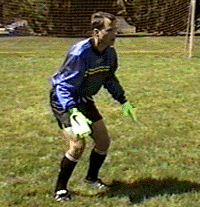Good footwork is the foundation of solid goalkeeping. If a keeper has quick feet, they can easily get themselves into position to make the easy catch, rather than having to dive at balls just at the edge of their reach all the time. Good goalkeepers make every save look easy, and the key to that is good footwork.
Footwork Principles
- Keep moving and stay on the toes. The feet of a good goalkeeper are constantly in motion, and they dance on the balls of the feet. A sure way for a keeper to get beat is to have their weight back on their heels. Watch for this! Not only does this keep them from moving quickly to a ball, but it has bad effects on their diving and jumping. Your keeper should have "happy feet", always bouncing on the toes and with their weight forward.
- Stay square to the ball.

Fig. 1: Stay square to the ball |
The goalkeepers hips and shoulders should always be square to the ball; that is, perpendicular to a line between the shooter/ball and the keeper. (Fig. 1). A common problem is for young keepers to turn sideways when collecting balls that aren't in front of them. Make sure they always square up - to do this, they must also... - Get behind the ball. It is easiest to make the save when the ball is directly in front of them, so they should use their feet to get behind the ball every time, if possible. A goalkeeper uses two types of steps to do this:
- Shuffle step - this is used for short distances. The body stays square to the ball, the feet shuffle quickly but never cross over. Right foot stays on the right, left on the left.
- Crossover step - used to cover more ground. Turn the hips and run in the direction they want to go, but with their upper body facing the ball. Again, don't cross the feet up - right on the right, left on the left. This is not a carioca or "grapevine" step, where one foot passes in front of and then behind the other alternately.
If there is a long way to go, use the crossover, then end with a few quick shuffles to adjust the final position for making the catch. A common problem, especially for young players, is to cross their feet and trip themselves up. Make sure right foot stays on the right, left on left. - Move forwards to the ball. The save should always be made forwards, moving towards the ball. This accomplishes two important things: it allows the keeper to get to the ball faster, and it gives the keeper the proper angle to deflect any balls that aren't caught away from the goal. Do not let your keeper take a step back when they catch the ball. If anything, they should take a step forward.
- Recover quickly, and always keep your hands free. Just because the goalkeeper goes down with a dive or slide does not mean the play is over. A parry or deflection may keep the ball in play, and perhaps send it right to an attacker! The goalkeeper must regain their feet as quickly as possible. Preferrably, this is done without using the hands so the hands are ready to make a stop if necessary. There is no set method for doing this, but goalkeepers should practice getting back up quickly and without the use of their hands.
Again, footwork is the foundation of solid goalkeeping! Often the difference between a save and a goal is just half a step. Use the feet to get the body behind the ball.
The Ready Position

Fig. 2: The ready position |
|


0 comments:
Post a Comment